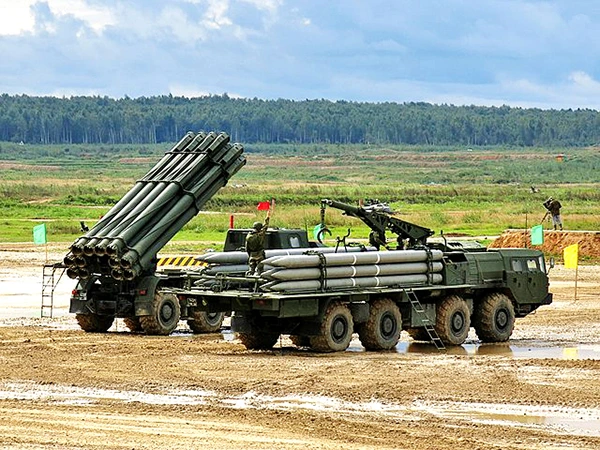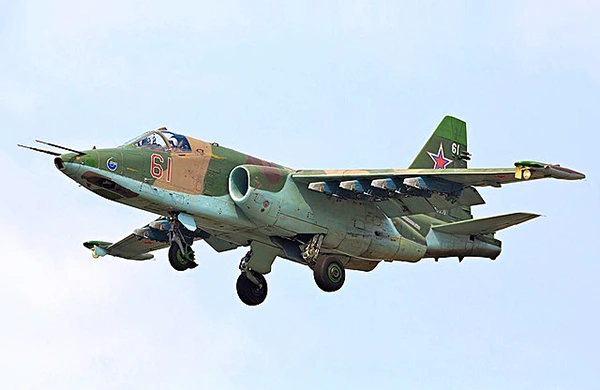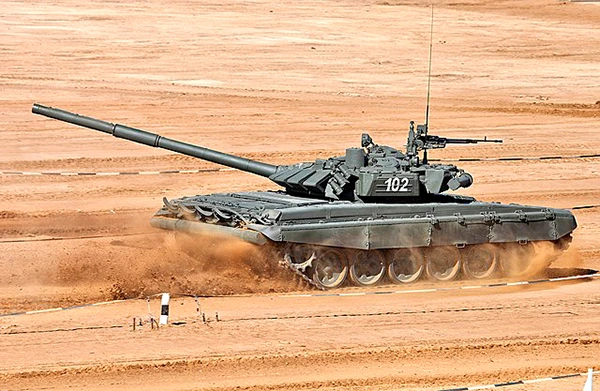One of the Russian weapons systems that has made a significant impact in the Ukraine War is the multiple rocket launcher system known as the BM-30 Smerch. The Smerch is a heavy multiple rocket launcher that can fire 300mm rockets over long distances with high accuracy. It has a range of up to 90 kilometers and can deliver devastating firepower to a wide area.
During the Ukraine War, the Smerch rocket launchers were used by Russian-backed separatist forces and by Russian military units as well. The Smerch rockets were employed in various offensives and counteroffensives, particularly in the Donbass region, targeting Ukrainian military positions and infrastructure.
Smerch system allowed the Russians to strike targets deep inside Ukrainian territory, including military bases, supply depots, and infrastructure critical to the Ukrainian military.
Characteristics of Smerch Weapon System
The BM-30 Smerch (also known as the 9K58 Smerch) is a Russian multiple rocket launcher system designed to deliver devastating firepower over a large area. Here are some key characteristics of the Smerch weapon system:
Range: The Smerch has an impressive maximum range of up to 90 kilometers (56 miles)which allows it to strike targets deep inside enemy territory.


Payload: The Smerch launcher carries 12 300mm rockets, each equipped with a high-explosive warhead. The rockets are unguided and rely on their sheer firepower and large blast radius to inflict damage on the target area.
Accuracy: Despite being unguided rockets, the Smerch system is known for its relatively high accuracy incorporating advanced targeting and fire control systems such as a satellite-based navigation system and a self-contained fire control system.
Firing Rate: The Smerch launcher is capable of a rapid-fire salvo, with all 12 rockets being launched in just 38 seconds. This allows for concentrated and overwhelming firepower within a short period.
Versatility: The Smerch launcher is mounted on a heavy-duty 8×8 truck chassis, providing mobility and ease of transport. It can quickly be deployed and relocated, enhancing its operational flexibility on the battlefield.
Destructive Power: Each rocket carries a large high-explosive warhead, capable of creating significant damage to infrastructure and causing casualties over a wide area.
Saturation Effect: The Smerch system’s ability to fire multiple rockets simultaneously creates a saturation effect on the target area, overwhelming enemy defenses and causing panic and disruption.
Reload Capability: The Smerch launcher is equipped with an automated reloading system that allows it to be reloaded within a relatively short time, enhancing its sustained firepower.
Overall, the Smerch multiple rocket launcher system combines long-range capability, high accuracy, and a large payload to deliver a powerful and destructive impact on the battlefield. Its ability to strike targets at a distance and saturate an area with rockets has made it a significant weapon system in the Ukraine War.
Fighter Aircraft
One of the Russian weapon systems in the air that has made a significant impact In the Ukraine War is the Sukhoi Su-25 ground-attack aircraft, also known by its NATO reporting name “Frogfoot.” The Su-25 is a dedicated close air support aircraft designed to provide direct air support to ground forces.
Here are some characteristics of the Su-25 and its impact in the Ukraine War:
Close Air Support Capability: The Su-25 is twin-engine, twin-tail design, specifically designed for close air support missions, with 30mm twin-barrel cannon, making it highly effective in engaging targets on the ground. It can carry a payload of 8,000 kg of ordnance, it has 10 external hard points that can carry various weapons, including rockets, bombs, and air-to-ground missiles, enabling it to engage a wide range of targets, such as armored vehicles, fortified positions, and enemy formations.


Durability and Survivability: The Su-25 is known for its rugged construction and high survivability. It features an armoured cockpit for the pilot and key systems, along with redundant flight controls and hydraulic systems, allowing it to withstand ground fire and operate in hostile environments.
Operational Range: The Su-25 has a considerable operational range (1000 kms on internal fuel), allowing it to cover large areas and provide close air support wherever needed.
Maneuverability and Low-Flying Capabilities: The Su-25 possesses excellent maneuverability, enabling it to operate effectively in the challenging and dynamic battlefield environments. It can fly at low altitudes, up to altitude of 7,000 meters at max 950 km/h, which helps it evade enemy air defenses and deliver accurate strikes on ground targets.
Target Acquisition and Navigation Systems: The Su-25 is equipped with sophisticated target acquisition and navigation systems, including forward-looking infrared (FLIR) sensors and electronic countermeasures. These systems enhance its ability to locate and engage targets accurately, even in adverse weather conditions or at night.
Psychological Impact: The presence of Su-25 aircraft in the Ukraine War had a significant psychological impact on the opposing forces. The aircraft’s distinctive appearance and sound, coupled with its ability to deliver precise and powerful airstrikes, contributed to a sense of fear and vulnerability among enemy troops.
Air Defense System
One of the Russian air defense systems that has made a significant impact is the Buk-M2 (NATO reporting name: SA-17 Grizzly) medium-range surface-to-air missile system. The Buk-M2 is a highly capable air defense system designed to engage a wide range of aerial threats, including aircraft, helicopters, and cruise missiles.


Here are some key characteristics of the Buk-M2 and its impact in the Ukraine War:
Range and Altitude Coverage: The Buk-M2 system has a maximum engagement range of up to 45 kilometers (28 miles) and can engage targets at altitudes of up to 25 kilometers (15.5 miles).
Multiple Target Engagement: The Buk-M2 is capable of engaging multiple targets simultaneously, thanks to its radar-guided missiles and advanced command and control system. It can track and engage several threats simultaneously, enhancing its effectiveness in defending against coordinated aerial attacks.
Anti-Aircraft Missiles: The Buk-M2 employs 9M317 missiles, which are surface-to-air missiles designed for medium-range engagements. These missiles have high maneuverability, radar guidance, and explosive warheads, making them highly effective against different types of aerial targets.
Mobility and Transportability: The Buk-M2 system is mounted on a tracked vehicle, providing excellent mobility and maneuverability.
Integration with Command and Control Systems: The Buk-M2 system is integrated into a larger air defense network, allowing it to receive target information from various radar sources and command and control centers.
Psychological Impact: The presence of the Buk-M2 system, along with other advanced air defense systems, created a significant deterrent and defensive advantage for the Russian-backed forces in the Ukraine War.
The Buk-M2 air defense system played a notable role in the Ukraine War, particularly during the downing of Malaysia Airlines Flight MH17 in 2014, where it was alleged to have been used. Its capabilities as a medium-range air defense system contributed to the overall air defense strategy of the Russian-backed forces, influencing the operational dynamics and limiting the effectiveness of Ukrainian air operations in the conflict.
Main Battle Tank
Several Russian tanks have been used in the Ukraine War. However, one tank that has been prominently used and had a significant impact is the T-72B3.
The T-72B3 is a modernized version of the T-72 main battle tank, which incorporates various upgrades to enhance its combat capabilities, including improved armor protection, upgraded fire control systems, and modernized communication equipment. Some characteristics and impacts of the T-72B3 in the Ukraine War include:
Firepower: The T-72B3 is armed with a 125mm smoothbore gun, capable of firing various types of ammunition, including armor-piercing fin-stabilized discarding sabot (APFSDS) rounds and high-explosive anti-tank (HEAT) rounds.
Armor Protection: The T-72B3 features improved composite and reactive armor, enhancing its protection against enemy projectiles.
Mobility: The tank is equipped with a powerful engine that allows it to achieve high speeds and maneuverability on various terrains.
It is worth noting that other Russian tanks, such as the older T-64, T-80, and even the more modern T-90, have also been observed in the conflict. However, the T-72B3 is widely considered one of the primary tank models used by Russian-backed forces in the Ukraine War and has demonstrated significant impact in battles, contributing to the Russian-backed forces’ ground superiority and the challenges faced by the Ukrainian military.













